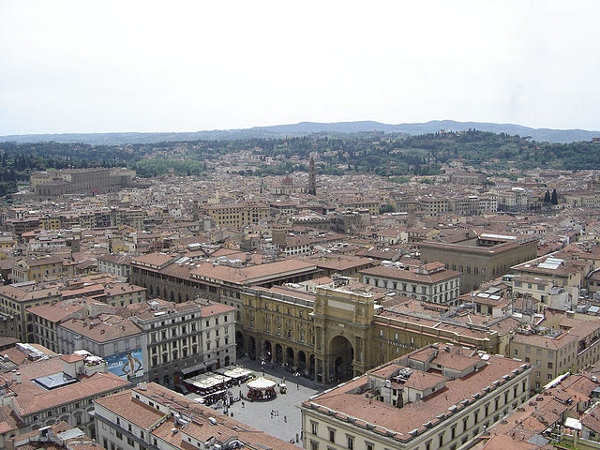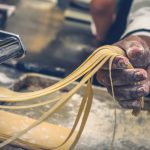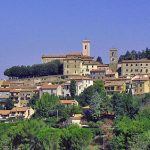Florence, city of art par excellence, born in Florence great names such as Dante, Boccaccio, Machiavelli and Galileo Galilei. Florence has also been graced by the works of Michelangelo, Brunelleschi, Botticelli, Donatello and Giotto.
Anyone visiting Florence is never left disappointed! This is due to a cultural and artistic heritage almost unique in Europe and in the world, which has its base in the Middle Ages and the Renaissance in its heyday. Florence, along with Rome, are the history of our civilization. In Florence, in the fifteenth century, were postte the basics to revive art and culture. Here, thanks to writers such as Dante, Petrarch, and Machiavelli was born the Italian culture and language. Artists such as Botticelli, Michelangelo and Donatello made one of the artistic capitals of the world.
SOME ‘OF HISTORY
Florence was founded in 59 BC by the Romans, who named Florentia.Si note the “cardo maximus” in the current Via Strozzi, Via degli Speziali and Via del Corso, and the “decumanus” Calimala in the street, Via Roma, Via Por Santa Maria . In the Piazza della Repubblica was the Forum. During the imperial period the city saw increasing its wealth, became a shopping center where there were craftsmen in the workshops, which then make the famous Florence. During the barbarian invasions, the city suffered many sieges by the Ostrogoths, the Byzantines and the Goths of Totila. Since the invasion of the Lombards at the first mention of a Duke in the city, the people gathered around the Bishops, in fact at that time they build monasteries, which became centers of culture and business. It was conquered by the Lombards in the sixth century, and only later the city emerged from the mists of the Middle Ages as a city-state indipendente.Quando the Lombards were defeated by the Franks, the Duke was replaced by Count. The Counts were succeeded by the Marquis, one should remember the admiration of the people of Florence for the Countess Matilda in 1085 that armed himself against Henry IV, and guaranteed to the town half a century of wise policy. He reached the highest heights of splendor between the eleventh and fifteenth centuries, becoming one of the major centers of power in Italy, a balance between the authority of the Emperors and Popes, overcoming the problems of internal fighting between the Guelphs and Ghibellines. In the fifteenth century Florence came under the rule of the Medici family, wealthy banking dynasty that later became the Grand Dukes of Tuscany. Florence and throughout Tuscany remained under the rule of the Medici family for three centuries. It was just that the heyday of the city, from the point of view of artistic, cultural, political and economic. The city grew in a frightening way. Painters, sculptors and architects filled streets, churches and buildings with the greatest works of the Renaissance. The Grand Duchy of the Medicis was succeeded, in the eighteenth century, that of Lorraine, until 1860, the year in which Tuscany became part of the Kingdom of Italy of which Florence was the capital from 1865 to 1871.
FLORENCE, 1000-1300
The city of Florence in the XI and XII expands and went to the south, on the right bank of the Arno. Over the river rose the first villages, and then in 1172 they built a second wall. Within the first wall, the urban fabric was very thick, consisting mainly of case-towers, however, between the first and second wall construction was much more sparse and regular, consisting of terraced houses. Between the twelfth and thirteenth century, the city increased its sales force, the core of this force is made by artisans, blacksmiths, shoemaker, of the goldsmiths, with particular development in the processing of wool. At the end of 1100 the city had reached its municipal autonomy. In the thirteenth century the government was made by the Consuls, with the help of Citizens Advice. Those who held power in the higher classes were chosen accordingly rivalry arose between the richest families. The families were brought together in alliances, this condition goes under the company name of the towers, the houses grew in height, if they became a fortress and by movable bridges, allied families, formed a system of towers easily defensible. The condition of the company town imposed an architecture of houses elongated vertically, with narrow openings, holes and brackets for the beams of the movable bridges. The discord between the major families became more and more severe until the formation of two parties, the Guelphs that loyal to the Pope hostile to the Emperor, and Ghibellines, loyal to the Emperor hostile to the Pope At first the Ghibellines had the upper hand, but the Their success was short and in 1250 the Guelphs returned to power. The City had a sort consists of the Signoria and the city enjoyed a period of great prosperity. In this period, the treaties of alliance with Lucca, Siena, Arezzo and purchases of Volterra, San Gimignano, Poggibonsi. All this wealth did rekindle the conflict between the Guelphs and Ghibellines, and after a short period of Ghibelline domain, the Guelphs resumed power and finally claimed their rule over the city. Great importance was divided into major and minor guilds, among the major arts were the Arte della Lana, that of Calimala, one of the Judges and Notaries, Physicians and Apothecaries, which brought wealth and prosperity in the city. At the end of the thirteenth century, is defined as the political and religious center of the city, with the construction of the Cathedral of Santa Maria del Fiore and Palazzo Vecchio. The triumph of the people, also led to the triumph of his tongue “vulgar”, which is stated as written and spoken language, because of all the dialects was the most harmonious. With the wealth was the desire to make the city more beautiful, have the first Florentine personalities such as Cimabue, Gaddo Gaddi for painting, Arnolfo di Cambio for sculpture, and announced the genius of Dante and Giotto. There is a plethora of churches: S. Michele Visdomini, SS. Apostles, St. Nicholas, Santa Margherita Sopr’Arno, which will be added to the Baptistery and the church of Santa Reparata.
Florence, 1300-1400
In the first half of the fourteenth century there are very important events for the social and economic life of Florence. Under the pressure of the growth phase, there were many plants of new towns, in fact the Walled Terre Florence, were intended to support the choices of the local political formations, taking the leadership. At the beginning of the century the urban fabric of the city and the development lines developed in the previous century do not undergo modifications background. L ‘last walls began in 1248, was completed in 1333, the circle included the towns and new industrial, religious, that were formed outside the doors of some of the existing roof, near the main road axes. Some of the new poles were born to the action carried out by various mendicant orders (Carmelites, Franciscans). These were orders from time settled in the vicinity of the previous circle, along the main routes: Via Romana, the paths towards the Valdarno, the way to the area of Prato – Pistoia, the way to Mugello and passes towards Bologna. In addition to these settlements along the circle you had settlements of a patrician, who had created important changes in the urban fabric. Then you notice a rise of new building types. The phenomenon was due especially to the richest families, who had strong interests in the countryside. Other changes occur in the area within the ancient circle of 1078, particularly in the area around the market. These interventions require a readjustment of the city to the new functional requirements and especially the image. This century is characterized by different lines of transformation of the urban fabric. Large families were the protagonists of the aggregation properties of the building, and typological transformations. In these classes we owe the creation of hospitals, charitable religious. The rules were issued by the Judiciary and bodies of the Municipality, and took care of the line referred to the initiatives of the public, so the places intended for public representation and the city’s infrastructure. Another line of transformation was that of the new building initiatives, the promoters were generally religious bodies or other corporations, such as the Arts The building type was that of houses arranged next to each other, located on lots with front road greatly reduced. The Florence of this century was renewed with respect to the thirteenth century, but the pattern of operation was always the same. The urban fabric was configured according to a hierarchical conception and in its parts, which in its functions, and then reflected the hierarchical structure of the institutions of the time. After that was completed last walls, the territory was divided into four districts, each district was divided into four banners. In the oldest, the one around the Old Market, there were the residences and shops of many ancient families, as well as major political offices. In particular, had settled the premises of the Arts principal. This is then presented as a very saturated, characterized by a street fabric minute, and a housing very thickened. In the confined space of the oldest part of the city, were opposed to the squares around the Cathedral and the Baptistery. A fabric was more contrasted between the band occupied by the penultimate circle and the circuit last circle. In this area the plot very dense houses and small shops, were the great monastic buildings or religious mendicant orders of the Franciscans and Dominicans. The towers were frequent in this part of town, some of which were incorporated in other buildings. In correspondence with small squares were the Lodges who welcomed meetings, becoming a standard in the relations of Florentine life. In the center of the city there were many construction sites, aimed at creating works of prestige, because continuing the work of the Cathedral (Santa Maria del Fiore), where it works is that the Talents Giotto, the Campanile of the Cathedral. Next to the cathedral were built, the church of Orsanmichele, the Loggia del Bigallo, working at the Loggia del Mercato, the Loggia dei Lanzi was redone the Dominican church of Santa Maria Novella, and the Franciscan Santa Croce, Palazzo del Podesta (the Bargello), the system Piazza Signoria. It also worked to Carraia Bridge and Old Bridge (rebuilt in 1345). An important feature was that the presence of shops on the bridges (now remained only on Ponte Vecchio). The work of architectural renovation of the city, were assigned to Arnolfo di Cambio, thanks to him the Gothic style, popular in Europe by the Order Cluniac, acquires a balanced character, mediating with the Romanesque style manages to get in buildings, both civil and religious, an example of Gothic solemn, with bursts of content and harmonious. The city was splitting into two distinct parts: a more centrally located to the north of the river, the other outer lying around the first. The course of the Arno functioned as the backbone for the whole city, in fact there were excavations river, mills, fulling mills, was also an important source to pick up gravel and sand for construction. The clear articulation between parts of the city not to be found in the distribution of classes in the urban fabric of the city. The upper classes were not above the contact with the subordinate classes, the social fabric was mixed, next to the palace of the noble was flanked by the workshops, the craftsmen’s workshops. At the end of the century we are increasingly close links between the citizens of Florence and the countryside. The landscape is modified by the interest of its citizens to invest in residences outside the city and the landscape takes on the appearance built and designed that has so captured the imagination of visitors.
FLORENCE, 1400
The fifteenth century is for the city of Florence, a moment of recovery, both economic and cultural. The glory that you have given life to these new impulses, which then express the concept of rebirth, renewal of art, which will give birth to the Renaissance, goes all the city, which becomes the focus of this cultural movement. The Renaissance since its first phase of training, around the beginning of the fifteenth century, develops new issues, approaching the ancient with the spirit of innovation. The movement appears to be closely connected with the new Florentine merchant class, and just the new class, consisting of the families of the Picts, the Rucellai, the Medici, Strozzi, become promoters of the new culture and the new architectural taste. The Medici family, first with Cosimo the Elder, then with Lorenzo the Magnificent, he collaborates with artists, philosophers, studying fervently that the real debug a conception of ‘man that expresses the desires of the new Signoria. As part of the culture of the Florentine Renaissance, Cosimo the Elder, who was the head of this great renewal movement, protecting the artists, encourages building initiatives and artistic useful to the city. In his dwellings met the Platonic Academy, Cosimo and after him Giuliano and Lorenzo were an active part in the debates, discussing good governance and art. Great fervor took place in the literary field, with Poggio Bracciolini, Coluccio Salutati, in philosophy, with Marsilio Ficino renewing the Platonic Academy at Careggi, we find in the architecture, Filippo Brunelleschi, followed by Michelozzo Michelozzo, Leon Battista Alberti, Bernardo Rossellini , Giuliano da Majano, Giuliano da San Gallo. Stimulation of this of this work is the study of ‘art, culture and the Greek and Roman philosophy, studied scientifically. The artist will use traditional techniques, with a new consciousness, trying to deepen the investigation into the nature of reality and then the Renaissance artist, following this path, it works by combining the art scientific knowledge, which becomes common matrix , from which the artist can not be separated. Nature and art, they become two important factors, the knowledge of reality presupposes the study and knowledge of new media, the artist will be in perspective, perspective, which becomes an instrument of knowledge to measure and reproduce reality. These new studies will give splendid results in the fields of painting and sculpture, and will form the basis of the greatest works of painting, architecture and sculpture. In architecture the new studies are answered in the work of Brunelleschi, Donatello and Masaccio with, a key figure of the Florentine Renaissance. His masterpiece is the dome of St. Maria del Fiore, which summarizes its activities in a comprehensive manner. In addition to the Dome, working at the Ospedale degli Innocent, the Old Sacristy of San Lorenzo, around 1423, the Church of San Lorenzo, the church of S. Spirit in 1436. Between 1429 and 1443, directed the work of the Pazzi Chapel, Brunelleschi was the creator of the classic Renaissance palace in Florence, Palazzo Pitti is an example. The new mercantile society, is revealed in the elegant and robust architecture of the mansion. We have initiatives of groups fixing power in areas not central residences, too, for the greater ease of finding areas in the outer zones of the fabric of the city. You therefore have important consequences for urban planning, projected towards the affirmation of the desire of the leadership group, and enter the phase involving the new types of Renaissance palaces. The buildings that are built tend to define a type of regular building, with a square plan, an inner courtyard with columns. Palazzo Medici, Palazzo Pitti, Palazzo Strozzi, Rucellai Palace, are the new buildings that reflect the assertion of the wealth and power of the leading Florentine families.
https://tuscanysea.com/backoffice/immagini/tuscanysea.com/20-17-5-2013-11-7-151.jpg
https://tuscanysea.com/backoffice/immagini/tuscanysea.com/20-17-5-2013-11-7-152.jpg



